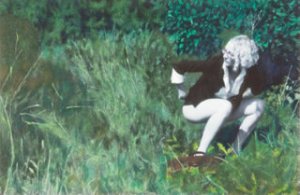Dear Diary,
[… continued from Art & Ukraine (Part 1), Art & Ukraine (Part 2), and Art & Ukraine (Part 3)…]
One cannot complete the survey of the contemporary Ukrainian art scene without the observation of three important contemporary art centres that operate in Kiev.
As mentioned above, even though after the collapse of the Soviet Union the minds and subject matter of Ukrainian artist have been liberated, in their majority they remained figurative painters who received – and followed – classic academic training based on centuries of traditional art teaching. Judging from the art on display in Kiev’s commercial galleries, the language of abstract and alternative art movements still remains foreign for contemporary art practitioners in Ukraine.
It therefore falls upon contemporary exhibition centres to educate the artists – and the masses – by staging exhibitions of contemporary art from abroad. In this area, Centre for Contemporary Art (formerly the Soros Centre for Contemporary Art – www.cca.kiev.ua), EIDOS Arts Development Foundation and Contemporary Arts Centre (www.eidosfund.org), and the Pinchuk Art Centre (www.pinchukartcentre.org) are invaluable to the cultural landscape of the present-day Ukraine.
Once again, I would like to quote from Larissa Babij:
… “The Center for Contemporary Art (CCA)… was one of the first institutions to introduce contemporary art practice to Ukraine. Originally funded by George Soros between 1993 and 1999 (as part of his program of Soros Centers for Contemporary Art in many Eastern European and post-Soviet countries), the CCA was a hub of exchange, bringing exhibitions of works of major contemporary art figures – such as Joseph Kosuth and Ilya Kabakov in 1999, or Andy Warhol in 2000 – to Ukraine, as well as supporting the development of local artists through grants and exhibitions. After 1999, the CCA became an independent institution and gradually lost the financial support of Soros. In recent years, amidst financial struggles, it served as a laboratory for nurturing the younger generation of Ukrainian artists. In December 2008, it officially closed its gallery space and took on the new name Foundation Center for Contemporary Art. However, it still functions as an archive and continues to support education and outreach programs, often in partnership with other organizations…
“The EIDOS Arts Development Foundation [www.eidosfund.org], established in 2005, … has made a priority of using art education and communication to cultivate the Ukrainian contemporary art community. Their regular events bring together artists, curators, critics, writers and students, with the intent of fostering connections between isolated groups (the so-called tusovkas). Such events not only supplement the limited art education available at the National Academy, but they also serve as a catalyst for forming relationships which may lead to further cooperation. The EIDOS Foundation also sponsored a grant competition for art projects in public space. The foundation’s activities, which often address the dialogue between contemporary art and its social context, help Ukrainian artists cultivate the professional skills necessary for further contact with international arts institutions and for realizing their projects. Recently, the EIDOS Arts Development Foundation and Ludmila Bereznitsky and Partner Gallery opened a new, sleek space for contemporary art in Kyiv – the EIDOS Contemporary Art Centre. The CAC plans to showcase both experimental work by young Ukrainian artists and international curatorial projects. The CAC also promotes Ukrainian new media and video art, which are seldom exhibited in private galleries partial to traditional media such as painting.
“Since its opening in 2006, the PinchukArtCentre (PAC), which is independently supported by billionaire collector Viktor Pinchuk, has dominated the public perception of contemporary art with its large gallery space in Kyiv. Through unparalleled financial resources for exhibiting art in Ukraine, the institution has succeeded in making contemporary art accessible to a wide Ukrainian and international public. With free admission, convenient visiting hours and extensive PR, the museum welcomes tens of thousands of visitors to each of its major exhibitions (about three per year). The most recent show, “Requiem,” is Damien Hirst’s biggest retrospective to date and includes the exclusive world premiere of works from his recent series “Skull Paintings.” Hirst visited Kyiv for the opening, and also donated medical equipment to a children’s hospital in a joint charitable venture with the Victor Pinchuk Foundation.
“Because the PAC is the only institution of its kind, scale and visibility, many Ukrainian visitors formulate their idea of contemporary art based solely on what they see there. Pinchuk’s collection, which includes works by Andreas Gursky, Jeff Koons and Damien Hirst, emphasizes artists with celebrity status and work that is expensive and spectacular. In Ukraine, radio news stories rate the most expensive contemporary artists, so there is a tendency to view art as a luxury item in the hands of the elite but on display to the public, not unlike other flashy commodities like the Bentley sedans in the showroom next door to the PAC.
“Today the three above-mentioned institutions operate simultaneously, albeit with a wide variation in resources and visibility. Each supports a particular aspect of the Ukrainian art scene, from the CCA’s laboratory setting to EIDOS’s cheering of art that engages with society to the PAC’s flaunting of affluence. However, local artists drift from one institution to another, in addition to forming their own alternative organizations and seeking support from private galleries.”
This concludes my foray into the contemporary Ukrainian art scene for the time being. From now on I will endeavour to keep my eye on its happenings, and report them as they occur. Certainly, some day in the future, perhaps on my next trip to Europe, I would love to revisit my “old stomping grounds” and discover the new ones.
By the way, if you wish to read the rest of Larissa Babij’s excellent article, see it at www.artmargins.com.
[© Eugene Barilo v. Reisberg 2010. This article is copyright, but the full or partial use is WELCOME with the full and proper acknowledgement.]



















